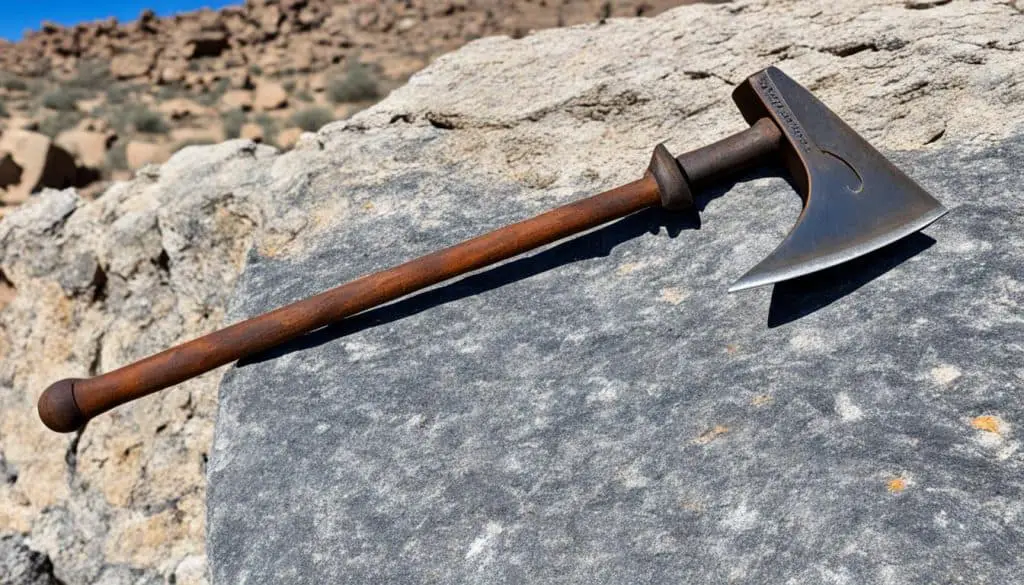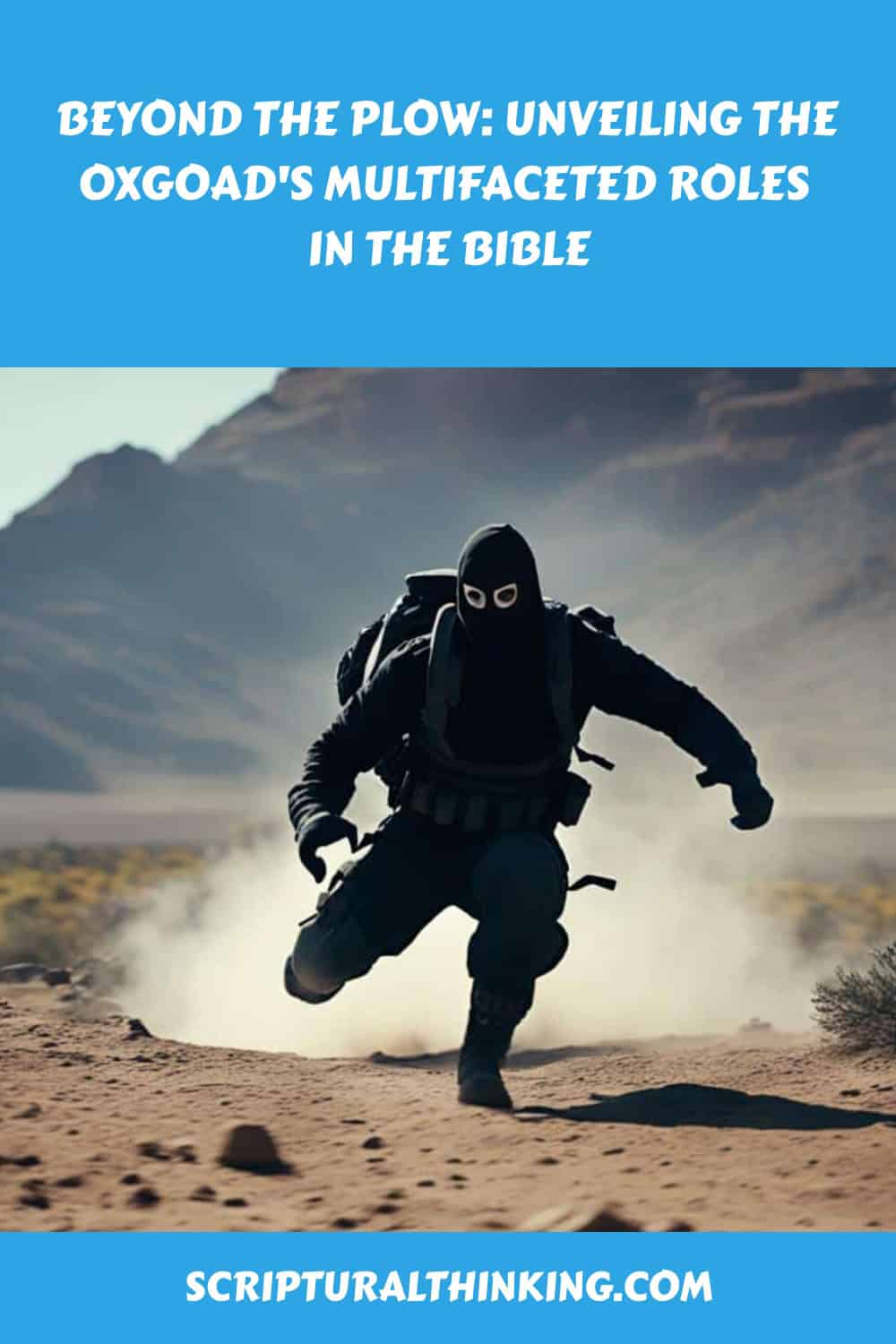Table of Contents
Have you ever wondered about the deeper meaning behind the tools mentioned in the Bible?
What if these seemingly ordinary objects held symbolic significance that could illuminate our understanding of scripture?
In this article, we will explore the symbolic significance of the oxgoad in Scripture.
From its dual role as a farming tool and a metaphor for guidance and inspiration, we will delve into various passages that highlight its importance and uncover its deeper meanings in biblical narratives.
Make Sure You Watch The Video: I would love for you to subscribe to my YouTube channel as well… Thanks in advance!!
Judges 3:31 – Shamgar’s Defense: The Power of an Oxgoad
In the book of Judges, chapter 3, verse 31, we find a fascinating account of Shamgar’s defense against the Philistines using an unconventional weapon: the oxgoad.
Shamgar, a judge of Israel, demonstrated the remarkable power and versatility of this tool, both as a farming implement and as a formidable weapon.
The oxgoad, typically used to guide oxen while plowing, was an unassuming tool that Shamgar transformed into a weapon of strength and protection. With it, he single-handedly defeated 600 Philistines, foiling their attempts to oppress the Israelites.
Shamgar’s use of the oxgoad serves as a testament to his resourcefulness and ingenuity in the face of adversity.
It highlights the oxgoad’s dual functionality as both a tool for cultivation and a weapon for defense, symbolizing the resilience and determination of the Israelites in their struggle against oppressors.
Moreover, Shamgar’s defense reinforces the significance of the oxgoad in ancient warfare. While traditional weapons such as swords and spears were common, Shamgar’s victory with the oxgoad showcases the effectiveness of alternative means of defense.
This event reminds us that true power does not always lie in conventional weaponry but can manifest in unexpected tools.
“With the oxgoad, Shamgar delivered his people from oppression, demonstrating the strength and prowess that can emerge from the most unlikely sources”
Shamgar’s triumph with the oxgoad reflects the broader theme of utilizing available resources in times of need and finding strength in unconventional methods. The story encourages us to recognize the power within our reach and empowers us to face challenges with creativity and determination.
| Key Points: |
|---|
| The oxgoad, initially a farming tool, served as a powerful weapon in Shamgar’s defense against the Philistines. |
| Shamgar’s victory emphasizes the dual functionality and versatility of the oxgoad. |
| By employing the oxgoad, Shamgar showcased the effectiveness of unconventional weapons in ancient warfare. |
| The story of Shamgar’s defense encourages us to tap into our inner resourcefulness and find strength in unexpected places. |
Shamgar’s extraordinary feat with the oxgoad reminds us that even ordinary tools can be transformed into something remarkable. It is a powerful testament to the resilience, ingenuity, and resourcefulness of individuals when faced with adversity.
1 Samuel 13:21 – Farming Necessities: Reliance on the Oxgoad
Exploring 1 Samuel 13:21, we discover the daily life reliance of the Israelites on the oxgoad.
This verse emphasizes their need to go to the Philistines to sharpen their oxgoads, illustrating the essential nature of this tool in their agricultural practices and highlighting the socio-economic control exerted through its monopolization.
The Israelites, living in an agrarian society, heavily relied on farming necessities to sustain their livelihoods. The oxgoad played a crucial role in their agricultural practices.
It was not just a simple farming tool but also a symbol of their dependence on the land for sustenance and survival.
In 1 Samuel 13:21, we witness the Israelites’ reliance on the oxgoad’s sharpness. The verse mentions their need to journey to the Philistines to sharpen their oxgoads.
This act of seeking external assistance for sharpening the oxgoads indicates the significance of a well-maintained and effective tool in their farming endeavors.
The sharpening of the oxgoad was a necessary task to ensure efficient plowing, helping the Israelites cultivate the land effectively. A dull oxgoad would make the process difficult and hinder their agricultural productivity.
By emphasizing the need for sharpening, this verse underscores the vital role the oxgoad played in their daily lives.
Furthermore, the requirement to travel to the Philistines for sharpening sheds light on the social and economic dynamics of the time.
This verse suggests that the Philistines held a monopoly over the knowledge and equipment necessary to maintain the oxgoad’s sharpness, exerting a degree of control over the Israelites’ agricultural practices.
The Israelites’ dependence on the Philistines for this essential service further solidified the power dynamics between the two groups.
This reliance on the oxgoad and the socio-economic implications surrounding its sharpening reveal the intricate connections between farming necessities and societal structures.
The Israelites’ agricultural practices were intertwined with their social and economic well-being, making the oxgoad a fundamental tool that represented their livelihoods as well as their position within the broader community.
The Importance of Sharpening
The act of sharpening the oxgoad was not merely a mechanical task but also symbolic. Keeping the oxgoad in optimal condition reflected the Israelites’ commitment to their farming responsibilities and their dedication to tending the land that sustained them.
Just as a sharp oxgoad provides ease in plowing and tilling the soil, a well-maintained tool reflects our diligence in nurturing the earth’s bounties.
The sharpening process served as a reminder of the constant effort required to thrive in an agricultural society. It symbolized the need for diligence, precision, and reliability in farming practices. By honing the oxgoad, the Israelites reinforced their commitment to a livelihood centered on the land and its cultivation.
| Importance of Sharpening | Symbolic Significance |
|---|---|
| Optimal plowing and tilling | Reflects diligence and nurturing |
| Efficiency in agricultural productivity | Demonstrates commitment to farming responsibilities |
| Smooth and effective cultivation | Symbolizes precision and reliability |
Ecclesiastes 12:11 – Words of the Wise: The Symbolism of the Oxgoad
In the book of Ecclesiastes, the wise author draws a fascinating parallel between the oxgoad and guidance, using symbolism that resonates with profound wisdom. In Ecclesiastes 12:11, it is written:
“The words of the wise are like goads, their collected sayings like firmly embedded nails—given by one shepherd.”
This metaphorical comparison evokes the image of the oxgoad in both its practical and symbolic aspects. Just as an oxgoad prods and directs cattle along a desired path, the words of the wise serve as goads that motivate, guide, and keep us on the right course.
Furthermore, the mention of “firmly embedded nails” emphasizes the enduring and unshakeable nature of these words, reinforcing their importance and impact.
This passage ignites contemplation on the profound significance of the oxgoad’s symbolism and how it relates to our modern lives. By viewing the words of the wise as goads and firmly embedded nails, we are reminded of the motivational force and lasting impact of guidance.
Just as an oxgoad provided direction to the plowman in ancient times, the wisdom imparted by mentors, teachers, and trusted individuals can steer us towards success, fulfillment, and personal growth.
Symbolic Unveiling
The symbolism of the oxgoad in Ecclesiastes 12:11 serves as a timeless reminder of the power of wise words and their ability to motivate, inspire, and redirect our lives.
By recognizing the enduring nature of guidance, we can cultivate a mindset open to wisdom, prioritize personal development, and seek out mentors who possess the knowledge and insight to guide us.
Applying Symbolism in Modern Context
In today’s fast-paced world, where distractions abound and guidance may seem elusive, the symbolism of the oxgoad in Ecclesiastes offers valuable lessons.
By internalizing the significance of this metaphor, we can actively seek out and cherish the words of the wise, finding solace, motivation, and direction in their guidance.
As we let these goads gently nudge us along our path and allow the firmly embedded nails to shape our thinking, we embark on a journey of continual growth and self-improvement.
Ultimately, the metaphorical significance of the oxgoad reminds us that wise words have the power to shape our destinies, transform our perspectives, and inspire positive action.
Just as the oxgoad provided vital guidance to the plowman, the guidance and wisdom we receive from the wise can be a catalyst for personal and spiritual development, steering us towards a life of purpose, fulfillment, and meaningful achievements.
| Symbolic Representation | Takeaway |
|---|---|
| The oxgoad as a goad | Powerful motivator that propels us towards growth and success |
| The oxgoad as a firmly embedded nail | Enduring impact and lasting wisdom |
| The role of guidance and wise words | Direction, inspiration, and personal development |
| Application in modern context | Seeking wisdom, cherishing guidance, and fostering continual growth |
| Utilizing wise words | Shaping destinies, transforming perspectives, and inspiring positive action |

Reflect on the symbolic representation of the oxgoad in Ecclesiastes 12:11, recognizing its timeless relevance, and let the wisdom of this metaphor guide your journey through life.
Acts 26:14 – Paul’s Conversion: Resistance against Divine Guidance
In Acts 26:14, we find Jesus’ powerful words to Paul, “it is hard for thee to kick against the pricks,” referencing the oxgoad. This metaphorical use of the oxgoad offers profound insights into human nature and the resistance often encountered when going against divine guidance.
“It is hard for thee to kick against the pricks.”
When Jesus speaks these words to Paul, he is metaphorically highlighting the futility and struggle that arises when resisting divine guidance.
Just as an ox, prodded by the goad of an oxgoad, experiences discomfort and resistance when trying to move against its intended direction, humans often resist God’s guidance, leading to conflict and inner turmoil.
Paul’s conversion serves as a remarkable example of this resistance. Prior to his encounter with Jesus, Paul vehemently opposed the teachings of Christ and persecuted early Christian communities.
Despite encountering divine intervention, he initially resisted the path of righteousness and experienced the consequences of his defiance.
Through the metaphor of the oxgoad, Acts 26:14 reminds us that our resistance to divine guidance can result in unnecessary hardships and limitations. By embracing the path that God intends for us, we can overcome resistance and find true fulfillment in our spiritual journeys.
Paul’s eventual acceptance of divine guidance transformed his life and led him to become one of the most influential figures in early Christianity. His story serves as a testament to the transformative power of yielding to God’s will, even when faced with resistance.
In our own lives, we may find ourselves kicking against the pricks, resisting the guidance and direction that God is offering us.
However, Acts 26:14 challenges us to reflect on the consequences of such resistance and the potential for growth and transformation when we surrender to divine guidance.
By acknowledging and examining the areas where we resist God’s leading, we can take steps towards aligning our lives with His plans and purposes.
In doing so, we can experience a deep sense of peace, purpose, and fulfillment, transcending the limitations imposed by our own resistance.
1 Kings 19:19-21 – Elisha’s Call: The Significance of the Oxgoad
In this section, we explore 1 Kings 19:19-21, where Elisha is found plowing with twelve yoke of oxen and uses his oxgoad in a significant life-changing decision. The story highlights the symbolic weight of the oxgoad in decision-making processes and underscores its significance in pivotal moments of our lives.
Elisha’s call serves as a powerful example of how the oxgoad can represent more than just a farming tool. It becomes a metaphor for making life-altering choices and embracing unforeseen opportunities. Like Elisha, we are often faced with crossroads where our decisions carry immense consequences.
The image below captures the essence of Elisha’s call and the significance of the oxgoad in his journey:

Elisha’s Call and Decision-Making Processes
In 1 Kings 19:19-21, we witness Elisha’s encounter with the prophet Elijah, who casts his mantle upon Elisha, signaling the passing of his prophetic duty.
Elisha, fully aware of the responsibility that awaits him, leaves everything behind to follow Elijah. In this pivotal moment, Elisha’s oxgoad becomes a catalyst for his decision-making process.
“Elijah passed by him and threw his mantle on him. He left the oxen and ran after Elijah” – 1 Kings 19:19-21
By leaving his oxen and oxgoad, Elisha symbolizes his commitment to his new calling. The oxgoad, an instrument of his previous trade, represents his willingness to let go of familiarity and embrace the unknown. It signifies the transformative power of making bold decisions and stepping into a new purpose.
The table below highlights the key elements of Elisha’s call and their symbolic significance:
| Elements | Symbolic Significance |
|---|---|
| Oxen | Represent the old way of life and comfort |
| Oxgoad | Serves as a metaphor for Elisha’s decision-making process |
| Elijah’s Mantle | Symbolizes the passing of Elijah’s prophetic duty to Elisha |
Elisha’s call resonates with us today, reminding us of the importance of discernment and the courage to embrace new paths. The oxgoad symbolizes our own decision-making processes, urging us to let go of the familiar and step into transformative moments.
Isaiah 2:4 – Beat Swords into Plowshares: Transformational Symbolism
Although not mentioning oxgoads directly, Isaiah 2:4 embodies the spirit of transforming weapons into agricultural tools.
This section invites reflection on the transformational symbolism of agricultural tools in peace-building narratives, drawing parallels to the significance of the oxgoad in promoting peace and reconciliation.
The verse in Isaiah 2:4 states, “They shall beat their swords into plowshares, and their spears into pruninghooks: nation shall not lift up sword against nation, neither shall they learn war any more.”
This powerful imagery portrays a vision of transformation, where military tools are repurposed for peaceful pursuits.

“And they shall beat their swords into plowshares, and their spears into pruninghooks: nation shall not lift up sword against nation, neither shall they learn war any more.” – Isaiah 2:4
This verse highlights the transformative nature of agricultural tools such as plowshares and pruninghooks, symbolizing the transition from conflict and destruction to productivity and sustenance.
It exemplifies the belief that the cessation of war can lead to the flourishing of society.
Just as the oxgoad symbolizes the transition from farming tool to a representation of guidance and inspiration, the metaphor of beating swords into plowshares signifies a shift from violence to peace.
This transformational symbolism resonates with the concept of reconciliation and harmony.
The power lies in realizing that the tools once used for harm can be reimagined for constructive purposes.
By reflecting on this verse, we are encouraged to seek ways to promote peace and reconciliation in our own lives, transforming conflict into understanding and division into unity.
The following table presents a comparison between war and peace, illustrating the transformative symbolism of the oxgoad and the concept of beating swords into plowshares:
| War | Peace |
|---|---|
| Conflict and destruction | Harmony and reconciliation |
| Violence and division | Understanding and unity |
| Swords and spears | Plowshares and pruninghooks |
This table highlights the symbolic contrast between war and peace, emphasizing the transformative power of choosing peaceful resolutions over conflict.
Just as the oxgoad serves as a tool of guidance and inspiration, beating swords into plowshares embodies the energetic aspiration to repurpose instruments of violence into agents of constructive change.
Judges 15:15 – Samson’s Jawbone of an Ass: Unconventional Weapons
In Judges 15:15, we encounter another instance of an unconventional weapon being employed with remarkable effect. Samson, known for his extraordinary strength, defeats a thousand Philistines using the jawbone of an ass as his weapon of choice.
This unexpected and unconventional choice of weaponry showcases Samson’s resourcefulness and cunning in the face of adversity.
Similar to the oxgoad, which was used by Shamgar in a previous section, the jawbone of an ass serves as a symbol of strength and defiance. It demonstrates the profound impact of using unconventional means to accomplish extraordinary feats.
Samson’s triumph with this unconventional weapon encapsulates the idea that true power lies not in the conventional tools of warfare, but in the resilience and ingenuity of the human spirit.
| Tool/Weapon | Character | Context | |
|---|---|---|---|
| 1 | Oxgoad | Shamgar | Defending against the Philistines |
| 2 | Jawbone of an Ass | Samson | Defeating a thousand Philistines |
As depicted in the table above, both the oxgoad and the jawbone of an ass exemplify the ingenuity and determination displayed by individuals when faced with adversity.
These unconventional weapons not only serve as tools of physical resistance but also carry deeper symbolic significance, representing the capacity of ordinary individuals to defy odds and deliver extraordinary outcomes.
Exodus 21:29-32 – Ox Goring Laws: Socio-Legal Importance
In Exodus 21:29-32, we encounter the importance of controlling oxen through the ox goring laws. Although the text does not explicitly mention goads, it indirectly implies their necessity in preventing and mitigating the damages caused by unruly oxen.
These laws provide us with valuable insights into the socio-legal structures of ancient societies and the measures taken to ensure public safety.
“But if the ox has had the habit of goring in the past and its owner has been warned but has not kept it in, and it kills a man or a woman, the ox shall be stoned, and its owner also shall be put to death. If a ransom is imposed on him, then he shall give for the redemption of his life whatever is imposed on him.” – Exodus 21:29-30
“If the ox gores a manservant or a maidservant, he shall give to their master thirty shekels of silver, and the ox shall be stoned.” – Exodus 21:32
These laws reveal the seriousness with which ancient societies regarded the dangers posed by aggressive oxen. They establish strict liability for owners who failed to properly control their animals, holding them accountable for any harm caused.
By implicitly acknowledging the use of goads for managing oxen, these laws underline the significance of these tools in maintaining the safety and order of communities.
Furthermore, these laws demonstrate the vested interest societies placed in protecting human life. The severe penalties imposed for the loss of life emphasize the value society attributed to human existence.
The requirement for payment of thirty shekels of silver in cases involving the injury of a servant establishes a standard compensation, ensuring fair treatment and accountability for damages caused by unruly oxen.
To fully grasp the societal impact of these ox goring laws and their implications for legal and moral responsibility, let us consider the following table:
| Ox Goring Laws | Key Insights |
|---|---|
| Strict liability for owners | Accountability for harm caused by aggressive oxen |
| Death penalty for owners | Deterrence against neglectful ownership and promoting public safety |
| Payment of thirty shekels of silver | Fair compensation for injury or loss caused to servants |
The table above summarizes the key insights gleaned from the ox goring laws in Exodus 21:29-32. These laws reveal the complex interplay between legal, moral, and societal considerations in ancient times.
They highlight the importance of maintaining order and ensuring the safety of communities while providing a framework for fair compensation and accountability.

Psalms 23:4 – Thy Rod and Thy Staff: Comfort and Guidance
In Psalms 23:4, the staff is portrayed as a powerful symbol of comfort and guidance. Similar to an oxgoad, the staff serves as a source of support and protection in our spiritual journeys.
It represents the unwavering presence of our divine guide, offering solace and reassurance in times of difficulty.
The concept of the staff in Psalms 23:4 demonstrates the profound care and compassion of our higher power. Like a shepherd leading and guiding their flock, the staff provides a sense of security and direction throughout our lives.
It serves as a reminder that we are not alone and that we can find comfort in the presence of a guiding force.
“Yea, though I walk through the valley of the shadow of death, I will fear no evil: for thou art with me; thy rod and thy staff they comfort me.”
Within this verse, the use of the words “rod” and “staff” emphasizes the dual role of the staff in offering both discipline and comfort.
The rod represents the disciplinary aspect, guiding us away from harmful paths and ensuring our spiritual growth. On the other hand, the staff represents the nurturing side, providing gentle support and guidance along our journey.
This multifaceted symbolism of the staff invites us to reflect on the many ways it influences and shapes our lives. It reassures us that even in the darkest moments, we can find comfort, solace, and the steady guidance necessary for our spiritual growth and well-being.

| Symbolism of the Staff in Psalms 23:4 | Implications for Our Spiritual Journeys |
|---|---|
| The staff as a symbol of comfort | Providing solace and reassurance in challenging times |
| The staff as a symbol of guidance | Offering direction and support in our spiritual paths |
| The rod as a symbol of discipline | Guiding us away from harmful paths and fostering spiritual growth |
| The staff as a symbol of nurture | Offering gentle support and care throughout our journey |
The Oxgoad’s Metaphorical Significance in Scripture
Throughout Scripture, the oxgoad holds a metaphorical significance that goes beyond its practical use in agricultural settings. As we have explored in the previous sections, the oxgoad is not merely a tool of labor but a symbol of guidance, strength, and defense.
By delving into various passages, we can uncover the profound lessons and deeper meanings conveyed through the representation of the oxgoad in biblical narratives.
The metaphorical significance of the oxgoad in Scripture invites us to reflect on its multi-faceted symbolism and draw relevant insights for our lives today. The oxgoad serves as a metaphor for guidance, pointing us in the right direction amidst the challenges and uncertainties we face.
Just as the farmer uses the oxgoad to steer the oxen, Scripture teaches us that God’s Word acts as our spiritual compass, guiding us on the path of righteousness.
Moreover, the oxgoad represents strength and defense. In the account of Shamgar in Judges 3:31, we witness the oxgoad’s powerful role as both a farming tool and a weapon.
This metaphorical imagery reminds us of the strength that lies within us, empowering us to face adversity and overcome obstacles that hinder our spiritual growth.
“For the word of God is alive and active. Sharper than any double-edged sword, it penetrates even to dividing soul and spirit, joints and marrow; it judges the thoughts and attitudes of the heart.” – Hebrews 4:12
Scripture often utilizes metaphors to convey profound truths, providing us with vivid imagery to grasp spiritual concepts more easily.
Just as Jesus used parables to teach valuable lessons, the oxgoad serves as a metaphorical vehicle that resonates with our human experiences and encourages us to deepen our understanding of God’s Word.
By recognizing the metaphorical significance of the oxgoad in Scripture, we can gain fresh insights and apply its lessons to our daily lives.
Whether in making important decisions, building relationships, or seeking spiritual guidance, the symbolism of the oxgoad invites us to depend on God’s wisdom and strength.
Through this metaphorical lens, we discover that Scripture is not merely a historical record but a living and relevant guide for our lives today.

| Symbolic Significance of the Oxgoad in Scripture | |
|---|---|
| Guidance | Steering us on the path of righteousness |
| Strength | Empowering us to face adversity |
| Defense | Protecting us from spiritual attacks |
| Metaphorical Tool | Providing vivid imagery to grasp spiritual concepts |
The metaphorical significance of the oxgoad in Scripture encourages us to explore its deeper meaning and apply its lessons to our lives. Just as the oxgoad guides and strengthens the farmer, so too can the Word of God guide and empower us on our spiritual journey.
How does the Oxgoad play a role in God’s provision as mentioned in Philippians 4:19?
The Oxgoad is a tool used by farmers to direct oxen and keep them on the right path. In Philippians 4:19, it symbolizes God’s provision in guiding and directing us toward His will. Just as an oxgoad provides the necessary guidance, God’s provision in Philippians 4:19 ensures that we have everything we need according to His riches.
Unveiling the Modern Implications of the Oxgoad’s Symbolism
As we reflect on the metaphorical significance of the oxgoad in biblical narratives, we uncover its timeless wisdom and relevance in our modern lives. While this ancient agricultural tool may seem distant from our daily experiences, its symbolism carries profound implications for us today.
The oxgoad, with its dual functionality as both a farming implement and a weapon, teaches us about adaptability and resourcefulness.
In an ever-changing world, we can draw inspiration from the oxgoad’s versatility. It prompts us to consider how we can embrace different roles and leverage our skills to navigate the challenges of the present.
Furthermore, the oxgoad’s symbolism invites us to reflect on perseverance and strength in the face of adversity.
Just as Shamgar used the oxgoad to defend against his enemies, we too can find inner resolve when confronted with obstacles. The oxgoad reminds us that resilience and determination can lead to triumph, even in the most challenging circumstances.
Ultimately, the oxgoad’s profound metaphorical significance calls us to examine our lives and find personal meaning in its lessons.
By understanding its ancient symbolism, we can uncover valuable insights that resonate in our modern world. Let the oxgoad encourage you to explore new possibilities, embrace challenges, and cultivate purpose in all that you do.






